Rare Earth Elements Geochemistry and 234U/238U, 235U/238U Isotope Ratios of the Kanyakumari Beach Placer Deposits: Occurrence and Provenance
Abstract
1. Introduction
2. Study Area
3. Materials and Methods
3.1. Sample Collection and Preparation
3.2. Major Oxides Analysis
3.3. Trace Elements, REEs, Th, and U Analysis
3.4. Chemical Separation of U
4. Results and Discussion
4.1. Major Oxides Geochemistry
4.2. REEs and Trace Elements Geochemistry
4.3. Enrichment of Rare Earth Elements, Th and U
4.4. 234U/238U Activity Ratios and 235U/238U Isotope Ratios of Kanyakumari HBNRA Sand
5. Conclusions
- The Kanyakumari beach sands are derived from an intensively weathered source region where most of the felsic minerals bearing Ca, Na, and K were removed and this is reflected through the CIA.
- The geochemistry of trace elements (Rb vs. Sr) suggests that the sands may be predominantly derived from the Trivandrum and Nagercoil Block of the Southern Granulite Terrains (SGT).
- Monazite has an enormous control on the REEs present along the Kanyakumari and this is reflected through the LREE-enriched patterns. Other heavy minerals such as ilmenite and zircon had control on HREEs and the beach sands showed a fractionated HREE pattern suggesting a minor control of these minerals on the REE.
- The 234U/238U activity ratio showed that the U in the Kanyakumari beach sands were in secular equilibrium and the 235U/238U isotope ratios were in close proximity to the natural terrestrial value of the 235U/238U isotope ratio.
- The δ238U suggests that Kanyakumari HBNRA placer sands are in the range of granite and granitoid which is the general composition of the rock types present in the hinterland.
Author Contributions
Funding
Data Availability Statement
Acknowledgments
Conflicts of Interest
References
- Nesbitt, H. Mobility and fractionation of rare earth elements during weathering of a granodiorite. Nature 1979, 279, 206–210. [Google Scholar] [CrossRef]
- McLennan, S.M.; Taylor, S.R. Rare earth element mobility associated with uranium mineralization. Nature 1979, 282, 247–250. [Google Scholar] [CrossRef]
- Sholkovitz, E.; Shen, G.T. The incorporation of rare earth elements in modern coral. Geochim. Cosmochim. Acta 1995, 59, 2749–2756. [Google Scholar] [CrossRef]
- Taylor, S.R.; McLennan, S.M. The Continental Crust: Its Composition and Evolution; Blackwell: Oxford, UK, 1985; Volume 312, pp. 673–674. [Google Scholar]
- Chakhmouradian, A.R.; Wall, F. Rare earth elements: Minerals, mines, magnets (and more). Elements 2012, 8, 333–340. [Google Scholar] [CrossRef]
- Cullers, R.L.; Barret, T.; Carlson, R.; Robinson, B. Rare-earth element and mineralogic changes in Holocene soil and stream sediment: A case study in the Wet Mountains, Colorado, USA. Chem. Geol. 1987, 63, 275–297. [Google Scholar] [CrossRef]
- Sholkovitz, E.R.; Elderfield, H. Cycyling of dissolved rare earth elements in Chesapeake Bay. Glob. Biogeochem. Cycles 1988, 2, 157–176. [Google Scholar] [CrossRef]
- Singh, P.; Rajamani, V. REE geochemistry of recent clastic sediments from the Kaveri floodplains, southern India: Implication to source area weathering and sedimentary processes. Geochim. Cosmochim. Acta 2001, 65, 3093–3108. [Google Scholar] [CrossRef]
- Sahoo, S.K.; Yonehara, H.; Kurotaki, K.; Shiraishi, K.; Ramzaev, V.; Barkovski, A. Determination of rare earth elements, thorium and uranium by inductively coupled plasma mass spectrometry and strontium isotopes by thermal ionization mass spectrometry in soil samples of Bryansk region contaminated due to Chernobyl accident. J. Radioanal. Nucl. Chem. 2001, 247, 341–345. [Google Scholar] [CrossRef]
- Balaram, V. Potential Future Alternative Resources for Rare Earth Elements: Opportunities and Challenges. Minerals 2023, 13, 425. [Google Scholar] [CrossRef]
- Balaram, V. Rare earth elements: A review of applications, occurrence, exploration, analysis, recycling, and environmental impact. Geosci. Front. 2019, 10, 1285–1303. [Google Scholar] [CrossRef]
- Van Gosen, B.S.; Fey, D.L.; Shah, A.K.; Verplanck, P.L.; Hoefen, T.M. Deposit Model for Heavy-Mineral Sands in Coastal Environments. In Mineral Deposit Models for Resource Assessment; U.S. Geological Survey Scientific Investigations Report; U.S. Geological Survey: Reston, VA, USA, 2014. [Google Scholar] [CrossRef]
- Singh, Y. Rare earth element geochemistry of monazites from beach sand deposits of Indian Coasts: Implications for clean energy. J. Appl. Geochem. 2020, 22, 209–220. [Google Scholar]
- Padua, J.C.; Basil Rose, M.R. Natural gamma radioactivity in the villages of Kanyakumari District, Tamil Nadu, India. Radiat. Prot. Dosim. 2013, 156, 42–48. [Google Scholar] [CrossRef] [PubMed]
- Ajithra, A.K.; Venkatraman, B.; Jose, M.T.; Chandrasekar, S.; Shanthi, G. Assessment of natural radioactivity and associated radiation indices in soil samples from the high background radiation area, Kanyakumari district, Tamil Nadu, India. Radiat. Prot. Environ. 2017, 40, 27–33. [Google Scholar] [CrossRef]
- Natarajan, T.; Sahoo, S.K.; Nakajima, T.; Veerasamy, N.; Yamazaki, S.; Inoue, K.; Ramola, R.C. Distribution of 226Ra, 232Th and 40K in Kanyakumari beach placer deposits along Tamil Nadu coast, India. J. Radioanal. Nucl. Chem. 2023. [Google Scholar] [CrossRef]
- Perumalsamy, C.; Bhadra, S.; Balakrishnan, S. Decoding evolutionary history of provenance from beach placer monazites: A case study from Kanyakumari coast, southwest India. Chem. Geol. 2016, 427, 83–97. [Google Scholar] [CrossRef]
- Sundar, S.; Roy, P.D.; Chokkalingam, L.; Ramasamy, N. Evaluation of metals and trace elements in sediments of Kanyakumari beach (southernmost India) and their possible impact on coastal aquifers. Mar. Pollut. Bull. 2021, 169, 112527. [Google Scholar] [CrossRef]
- Veerasamy, N.; Murugan, R.; Kasar, S.; Inoue, K.; Kavasi, N.; Balakrishnan, S.; Arae, H.; Fukushi, M.; Sahoo, S.K. Geochemical characterization of monazite sands based on rare earth elements, thorium and uranium from a natural high background radiation area in Tamil Nadu, India. J. Environ. Radioact. 2021, 232, 106565. [Google Scholar] [CrossRef]
- Ivanovich, M.; Harmon, R.S. Uranium-Series Disequilibrium: Applications to Earth, Marine, and Environmental Sciences, 2nd ed.; Natural Environment Research Council: Keyworth, UK, 1992; p. 910. [Google Scholar]
- Sahoo, S.K.; Nakamura, Y.; Shiraishi, K.; Masuda, A. Accurate measurement of uranium isotope ratios in soil samples using thermal ionization mass spectrometry equipped with a warp energy filter. Int. J. Environ. Anal. Chem. 2004, 84, 919–926. [Google Scholar] [CrossRef]
- Moreira-Nordemann, L.M. Use of 234U/238U disequilibrium in measuring chemical weathering rate of rocks. Geochim. Cosmochim. Acta 1980, 44, 103–108. [Google Scholar] [CrossRef]
- Latham, A.G.; Schwarcz, H.P. On the possibility of determining rates of removal of uranium from crystalline igneous rocks using U-series disequilibria-1: A U-leach model, and its applicability to whole-rock data. Appl. Geochem. 1987, 2, 55–65. [Google Scholar] [CrossRef]
- Kanai, Y.; Sakamaki, Y. Uranium redistribution implied by 234U/238U disequilibrium study on apatite-bearing sedimentary rocks at Nakamaruke district, central Japan. Appl. Geochem. 1994, 9, 547–552. [Google Scholar] [CrossRef]
- Veerasamy, N.; Kasar, S.; Murugan, R.; Inoue, K.; Natarajan, T.; Ramola, R.C.; Fukushi, M.; Sahoo, S.K. 234U/238U disequilibrium and 235U/238U ratios measured using MC-ICP-MS in natural high background radiation area soils to understand the fate of uranium. Chemosphere 2023, 323, 138217. [Google Scholar] [CrossRef]
- Bopp IV, C.J.; Lundstorm, C.C.; Johnson, T.M.; Sanford, R.A.; Long, P.E.; Williams, K.H. Uranium 238U/235U isotope ratios as indicators of reduction: Results from an in situ biostimulation experiment at Rifle, Colorado, USA. Environ. Sci. Technol. 2010, 44, 5927–5933. [Google Scholar] [CrossRef]
- Brennecka, G.A.; Borg, L.E.; Hutcheon, I.D.; Sharp, M.A.; Anbar, A. Natural variations in uranium isotope ratios of uranium ore concentrates: Understanding the 238U/235U fractionation mechanism. Earth Planet. Sci. Lett. 2010, 291, 228–233. [Google Scholar] [CrossRef]
- Murphy, M.J.; Stirling, C.H.; Kaltenbach, A.; Turner, S.P.; Schaefer, B.F. Fractionation of 238U/235U by reduction during low temperature uranium mineralisation processes. Earth Planet. Sci. Lett. 2014, 388, 306–317. [Google Scholar] [CrossRef]
- Mishra, S.; Kasar, S.; Takamasa, A.; Veerasamy, N.; Sahoo, S.K. Measurement of uranium distribution coefficient and 235U/238U in soils affected by Fukushima dai-ichi nuclear power plant accident. J. Environ. Radiact. 2019, 198, 36–42. [Google Scholar] [CrossRef]
- Chernyshev, I.V.; Golubev, V.N.; Chugaev, A.V.; Baranova, A.N. 238U/235U isotope ratio variations in minerals from hydrothermal uranium deposits. Geochem. Int. 2014, 52, 1013–1029. [Google Scholar] [CrossRef]
- Heiss, J.; Condon, D.J.; McLean, N.; Noble, S.R. 238U/235U systematics in terrestrial uranium-bearing minerals. Science 2012, 335, 1610–1614. [Google Scholar] [CrossRef]
- Stirling, C.H.; Anderson, M.B.; Potter, E.K.; Halliday, A.N. Low-temperature fractionation of uranium. Earth Planet. Sci. Lett. 2007, 264, 208–225. [Google Scholar] [CrossRef]
- Weyer, S.; Anbar, A.D.; Gerdes, A.; Gordon, G.W.; Algeo, T.J.; Boyle, E.A. Natural fractionation of 238U/235U. Geochim. Cosmochim. Acta 2008, 72, 345–359. [Google Scholar] [CrossRef]
- Santosh, M.; Yokoyama, K.; Biju-Sekhar, S.; Rogers, J.J.W. Multiple tectonothermal events in the granulite blocks of Southern India revealed from EPMA dating: Implications on the history of Supercontinents. Gondwana Res. 2003, 6, 29–63. [Google Scholar] [CrossRef]
- Rajesh, H.M.; Santosh, M.; Yoshikura, S. The Nagercoil charnockite: A magnesian, calcic to calc-alkalic granitoid dehydrated during a granulite-facies metamorphic event. J. Petrol. 2011, 52, 375–400. [Google Scholar] [CrossRef]
- Angusamy, N.; Rajamanickam, G.V. Distribution of heavy minerals along the beach from Mandapam to Kanyakumari, Tamil Nadu. J. Geol. Soc. India 2000, 56, 199–211. [Google Scholar]
- Kaliraj, S.; Chandrasekar, N.; Ramachandran, K.K. Mapping of coastal landforms and volumetric change analysis in the south west coast of. Kanyakumari, South India using remote sensing and GIS techniques. Egypt J. Remote Sens. Space Sci. 2017, 20, 265–282. [Google Scholar] [CrossRef]
- Veerasamy, N.; Sahoo, S.K.; Inoue, K.; Arae, H.; Fukushi, M. Geochemical behavior of uranium and thorium in sand and sandy soil samples from a natural high background radiation area of the Odisha coast, India. Environ. Sci. Pollut. Res. 2020, 27, 31339–31349. [Google Scholar] [CrossRef]
- Kasar, S.; Murugan, M.; Arae, H.; Aono, T.; Sahoo, S.K. A microwave digestion technique for the analysis of rare earth elements, thorium and uranium in geochemical certified reference materials and soils by inductively coupled plasma mass spectrometry. Molecules 2020, 25, 5178. [Google Scholar] [CrossRef]
- Kasar, S.; Aono, T.; Sahoo, S.K. Precise measurement of 234U/238U, 235U/238U and 236U/238U isotope ratios in Fukushima soils using thermal ionization mass spectrometry. Spectrochim. Acta B At. Spectrosc. 2021, 180, 106161. [Google Scholar] [CrossRef]
- Roser, B.P.; Cooper, R.A.; Nathan, S.; Tulloch, A.J. Reconnaissance sandstone geochemistry, provenance, and tectonic setting of the lower Paleozoic terranes of the West Coast and Nelson, New Zealand. N. Z. J. Geol. Geophys. 1996, 39, 1–16. [Google Scholar] [CrossRef]
- Anitha, J.K.; Joseph, S.; Rejith, R.G.; Sundararajan, M. Monazite chemistry and its distribution along the coast of Neendakara–Kayamkulam belt, Kerala, India. SN Appl. Sci. 2020, 2, 812. [Google Scholar] [CrossRef]
- Ganapathi Rao, P.; Bangaku Naidu, K.; Reddy, K.S.N.; Sekhar, C.R.; Murali Krishna, K.N.; Anji Reddy, M. Geochemical studies of monazites from coastal sands of Kandivalasa–Dibbalapalem coast, Andhra Pradesh. J. Earth Syst. Sci. 2020, 129, 143. [Google Scholar] [CrossRef]
- Van Hao, D.; Nguyen Dinh, C.; Jodlowski, P.; Kovacs, T. High-level natural radionuclides from the Mandena deposit, South Madagascar. J. Radioanal. Nucl. Chem. 2019, 319, 1331–1338. [Google Scholar] [CrossRef]
- Nesbitt, H.W.; Young, G.M.; McLennan, S.M.; Keays, R.R. Effects of chemical weathering and sorting on the petrogenesis of siliciclastic sediments, with implications for provenance studies. J. Geol. 1996, 104, 525–542. [Google Scholar] [CrossRef]
- Tomson, J.K.; Bhaskar Rao, Y.J.; Vijaya Kumar, T.; Mallikharjuna Rao, J. Charnockite genesis across the Archaean–Proterozoic terrane boundary in the South Indian Granulite Terrain: Constraints from major–trace element geochemistry and Sr–Nd isotopic systematics. Gondwana Res. 2006, 10, 115–127. [Google Scholar] [CrossRef]
- Rudnick, R.L.; Gao, S.; Holland, H.D.; Turekian, K.K. Composition of the Continental Crust. In The Crust; Rudnick, R.L., Ed.; Elsevier-Pergamon: Oxford, UK, 2003; Volume 3, pp. 1–64. [Google Scholar]
- Narayana, B.L.; Rama Rao, P.; Reddy, G.L.N.; Divakara Rao, V. Geochemistry and origin of megacrystic granitoid rocks from Eastern Ghats Granulite Belt. Gondwana Res. 1999, 2, 105–115. [Google Scholar] [CrossRef]
- Gao, P.; Santhosh, M.; Yang, C.; Kwon, S.; Ramkumar, M. High Ba–Sr adakitic charnockite suite from the Nagercoil Block, southern India: Vestiges of Paleoproterozoic arc and implications for Columbia to Gondwana. Geosci. Front. 2021, 12, 101126. [Google Scholar] [CrossRef]
- Veerasamy, N.; Sahoo, S.K.; Murugan, R.; Kasar, S.; Inoue, K.; Fukushi, M.; Natarajan, T. ICP-MS measurement of trace and rare earth elements in beach placer-deposit soils of Odisha, east coast of India, to estimate natural enhancement of elements in the environment. Molecules 2021, 26, 7510. [Google Scholar] [CrossRef]
- Anjos, R.M.; Veiga, R.; Macario, K.; Carvalho, C.; Sanches, N.; Bastos, J.; Gomes, P.R.S. Radiometric analysis of Quaternary deposits from the southeastern Brazilian coast. Mar. Geol. 2006, 229, 29–43. [Google Scholar] [CrossRef]
- Nyakairu, G.W.A.; Koeberl, C. Mineralogical and chemical composition and distribution of rare earth elements in clay-rich sediments from central Uganda. Geochem. J. 2001, 35, 13–28. [Google Scholar] [CrossRef]
- Telus, M.; Dauphas, N.; Moynier, F.; Tissot, F.L.H.; Teng, F.; Nabelek, P.I.; Craddock, P.R.; Groat, L.A. Iron, zinc, magnesium and uranium isotopic fractionation during continental crust differentiation: The tale from migmatites, granitoids, and pegmatites. Geochim. Cosmochim. Acta 2012, 97, 247–265. [Google Scholar] [CrossRef]
- Noordmann, J.; Weyer, S.; Bastian Georg, R.; Jöns, S.; Sharma, M. 238U/235U isotope ratios of crustal material, rivers and products of hydrothermal alteration: New insights on the oceanic U isotope mass balance. Isot. Environ. Health Stud. 2016, 52, 141–163. [Google Scholar] [CrossRef]


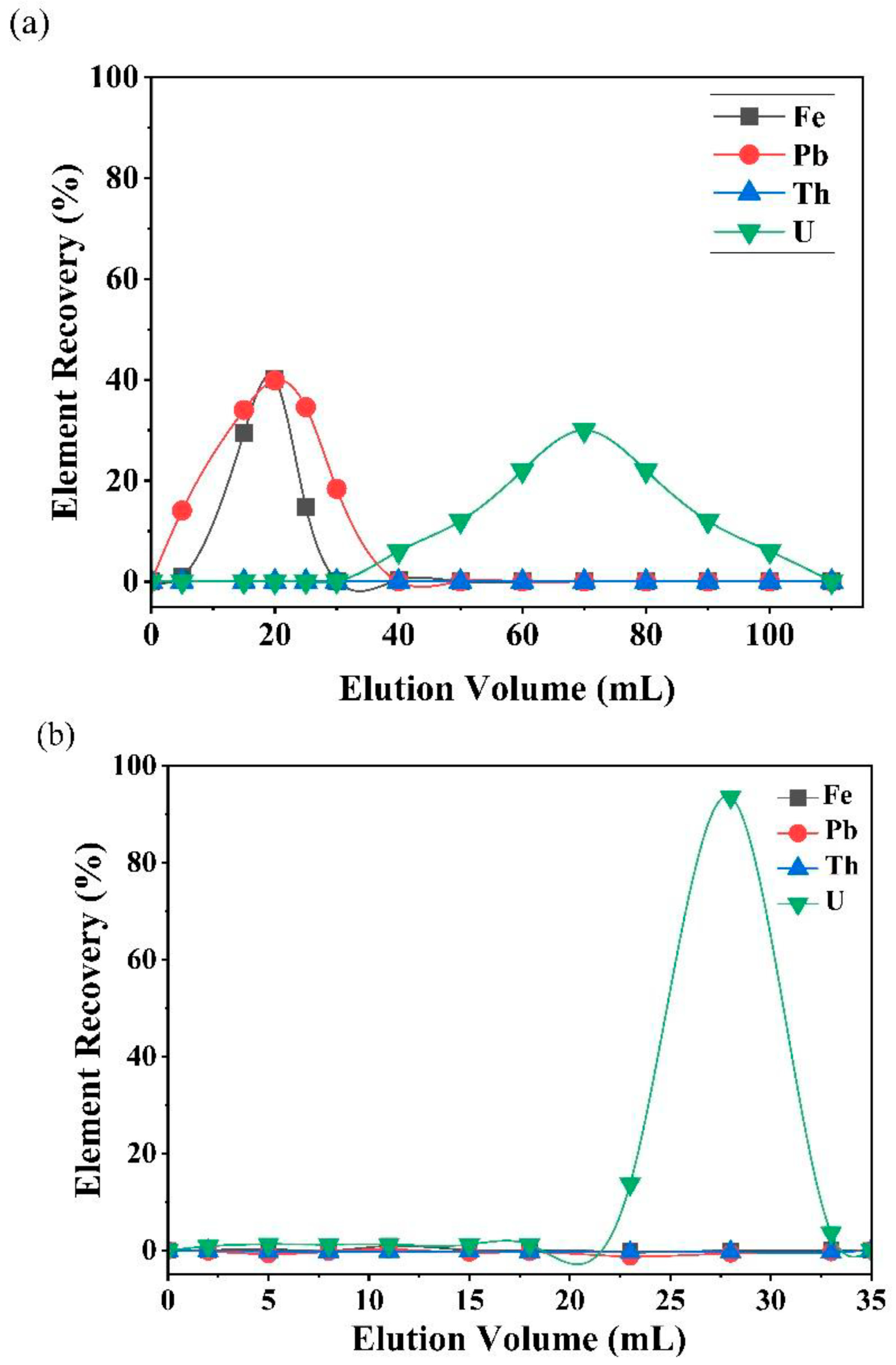

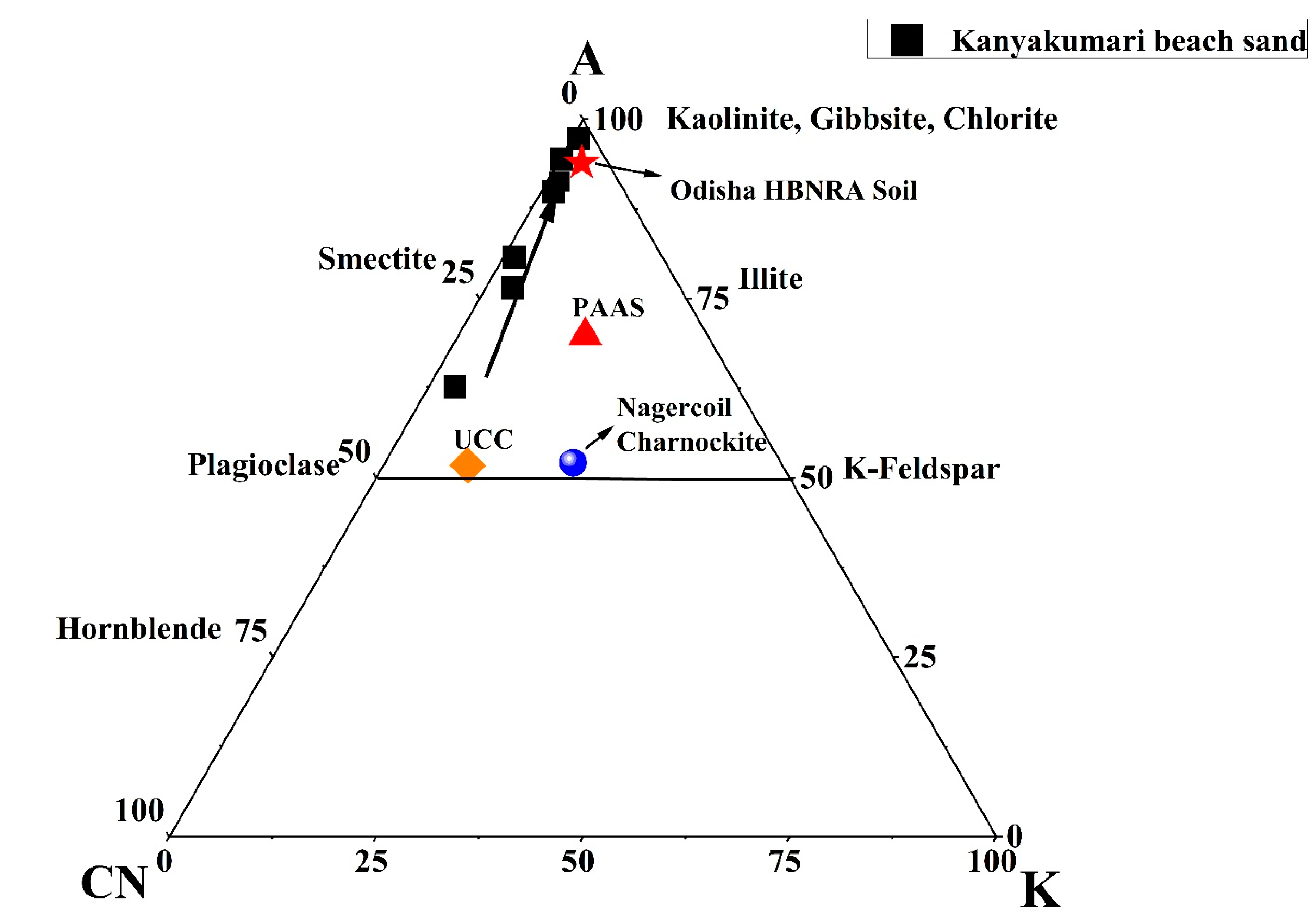
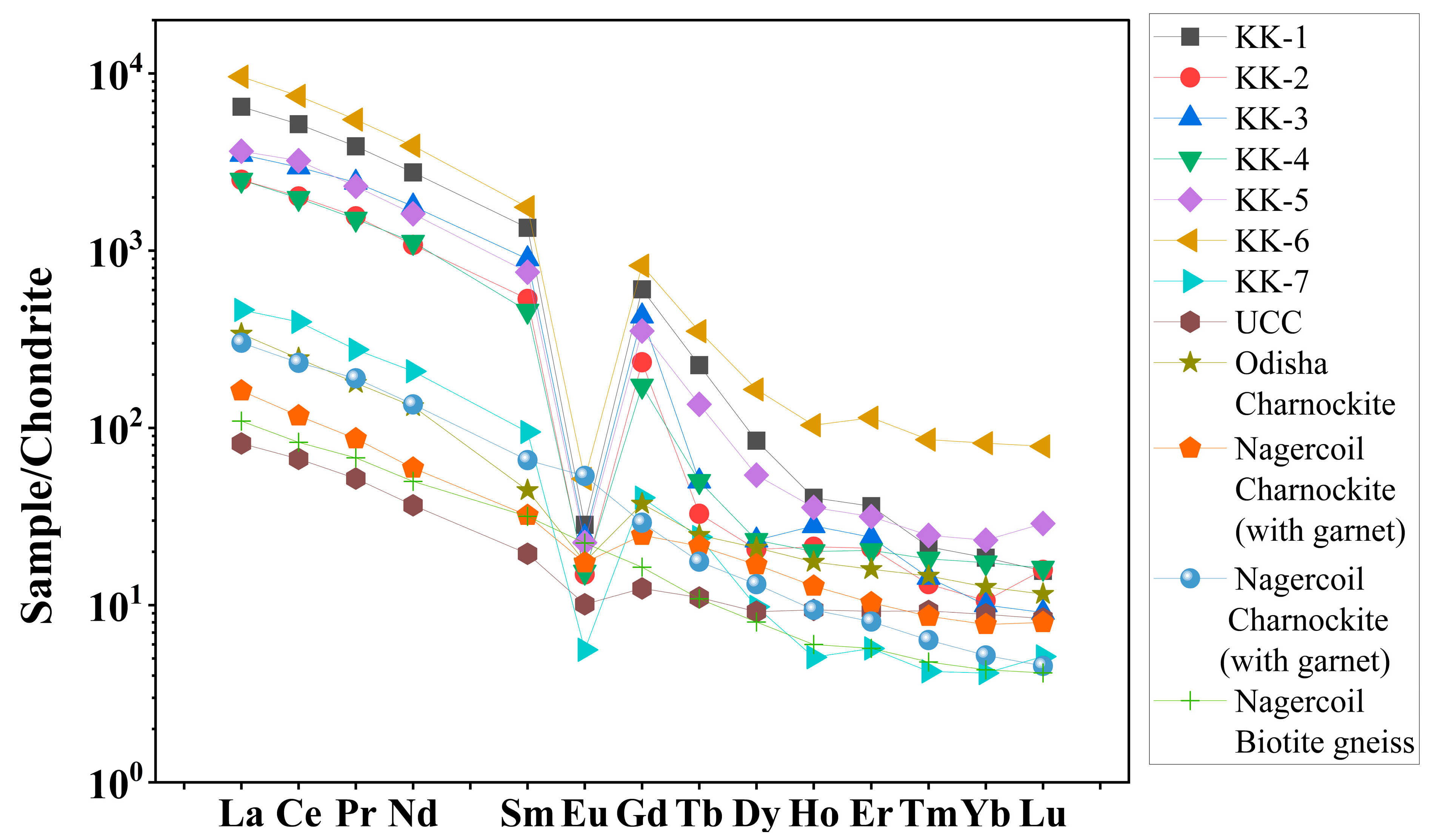
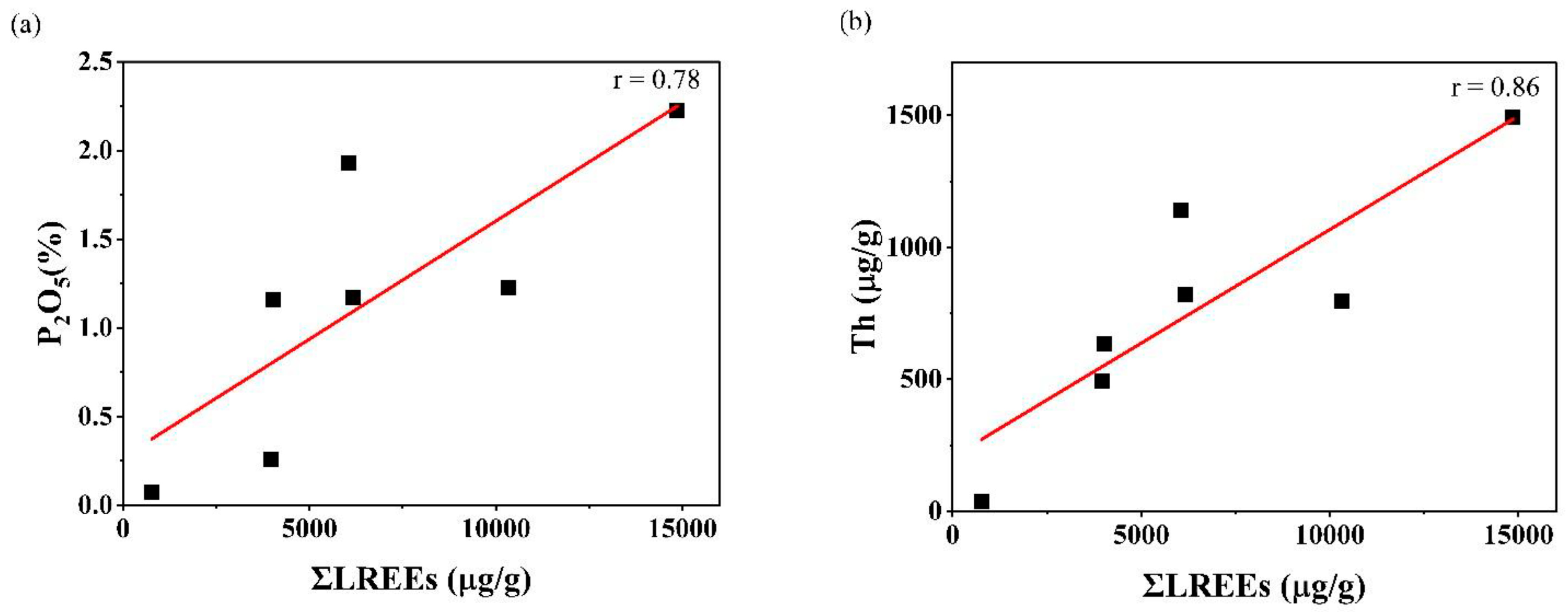
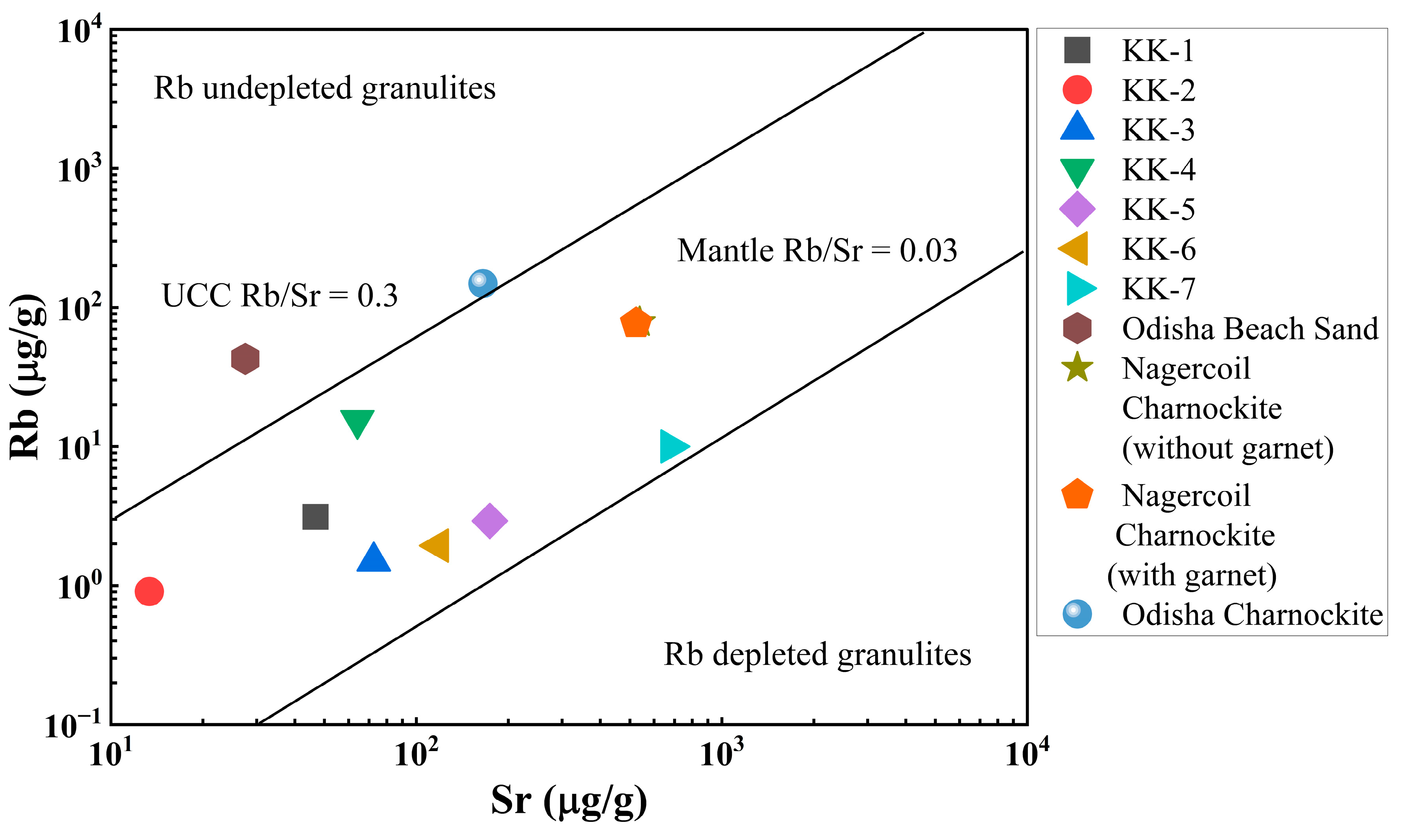
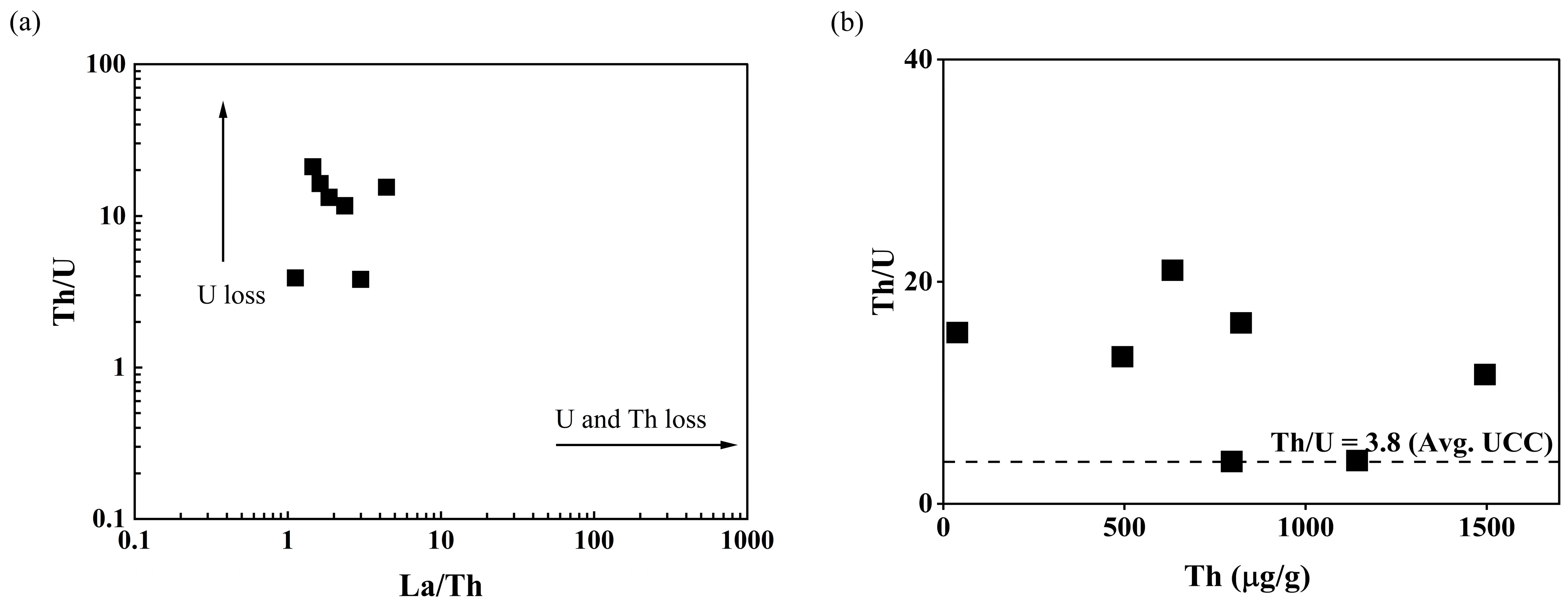
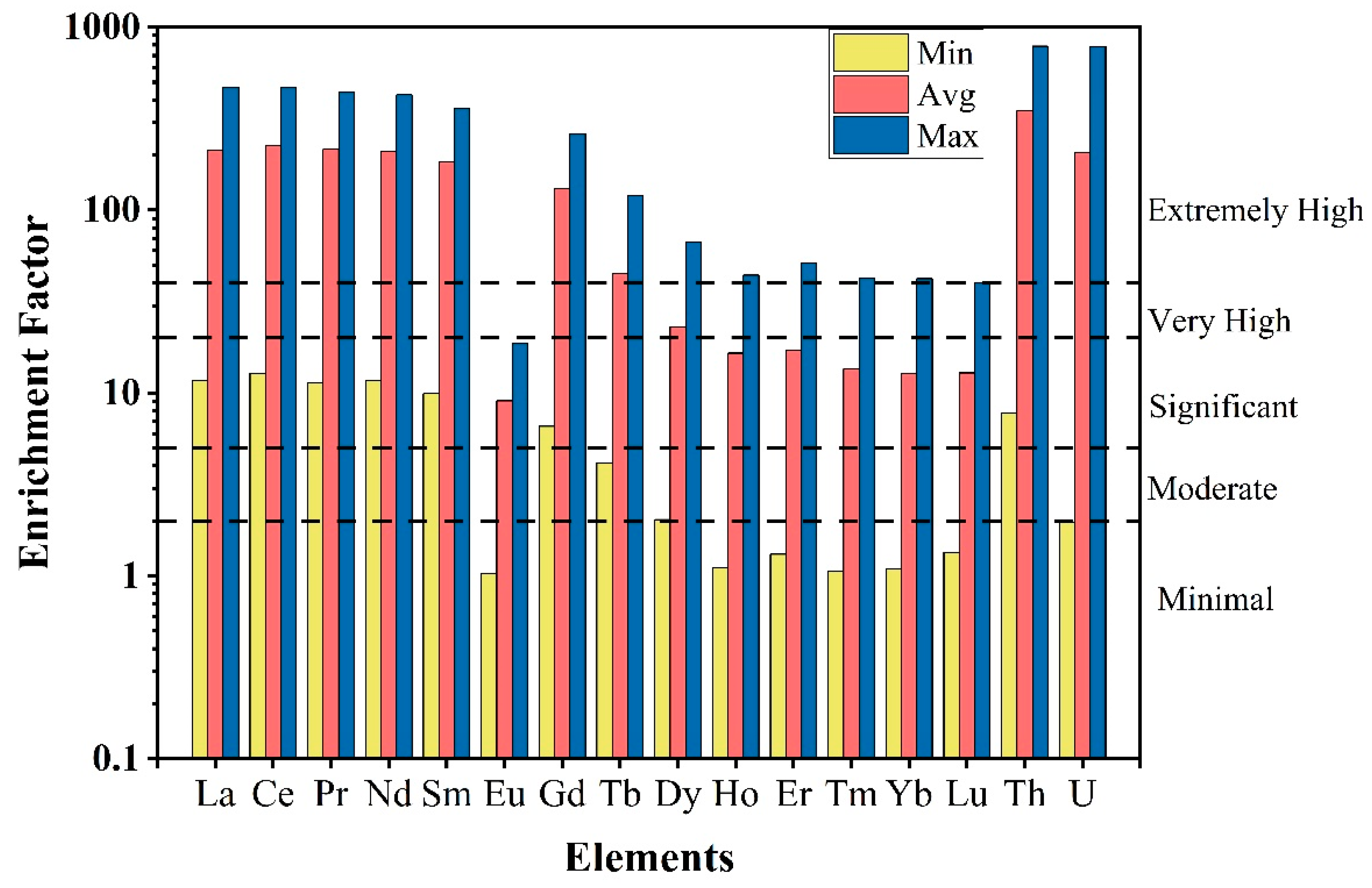
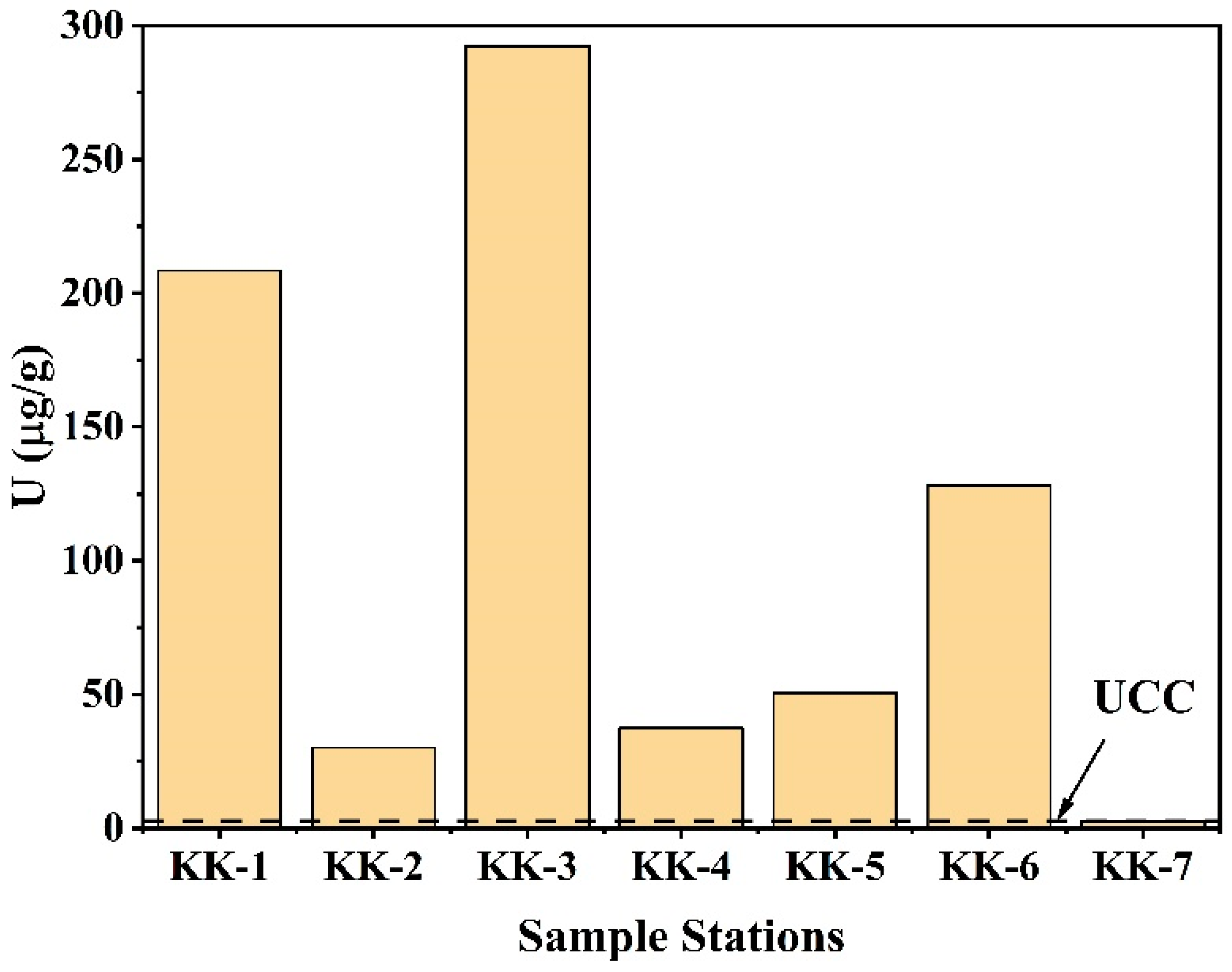
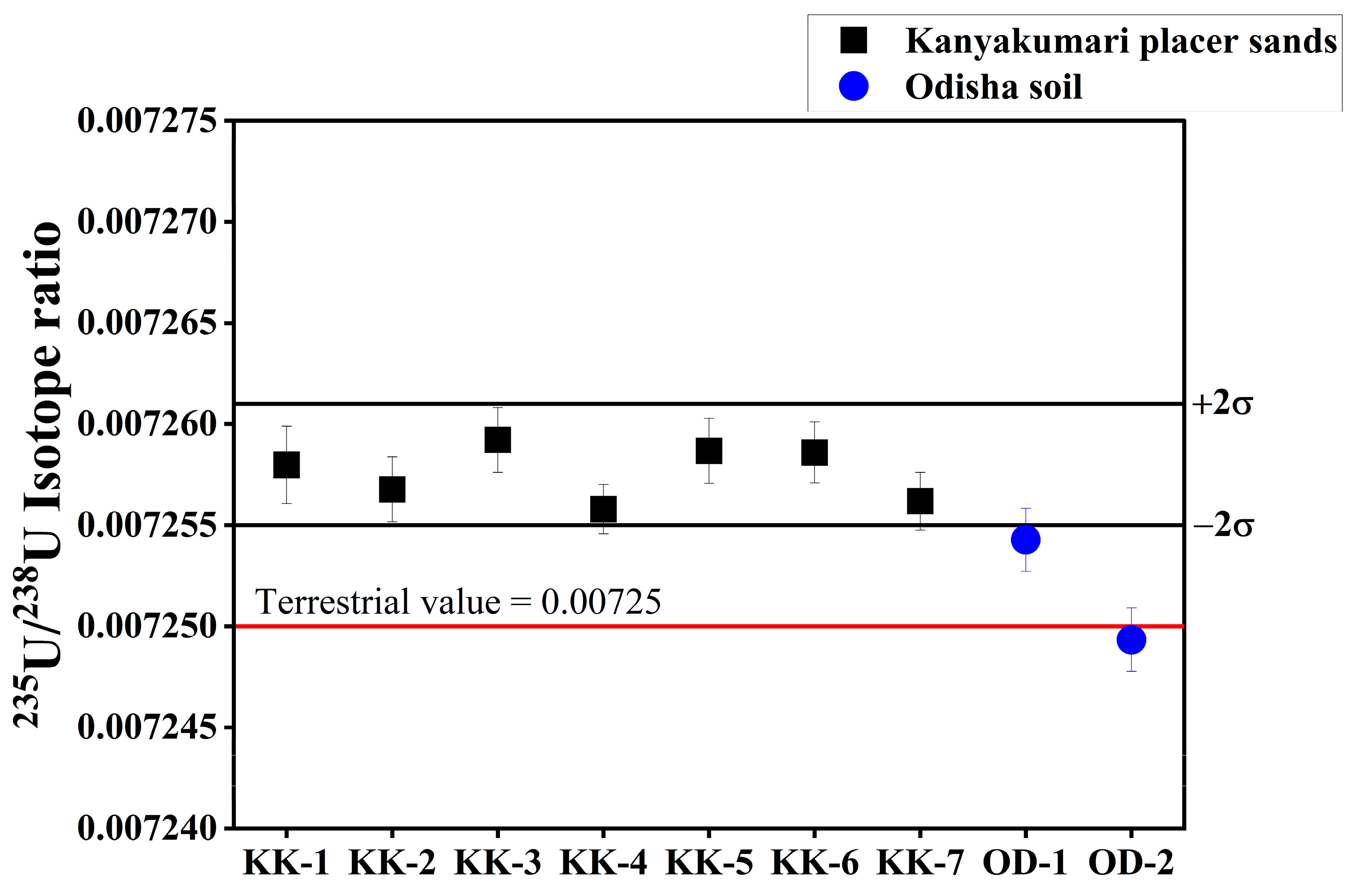
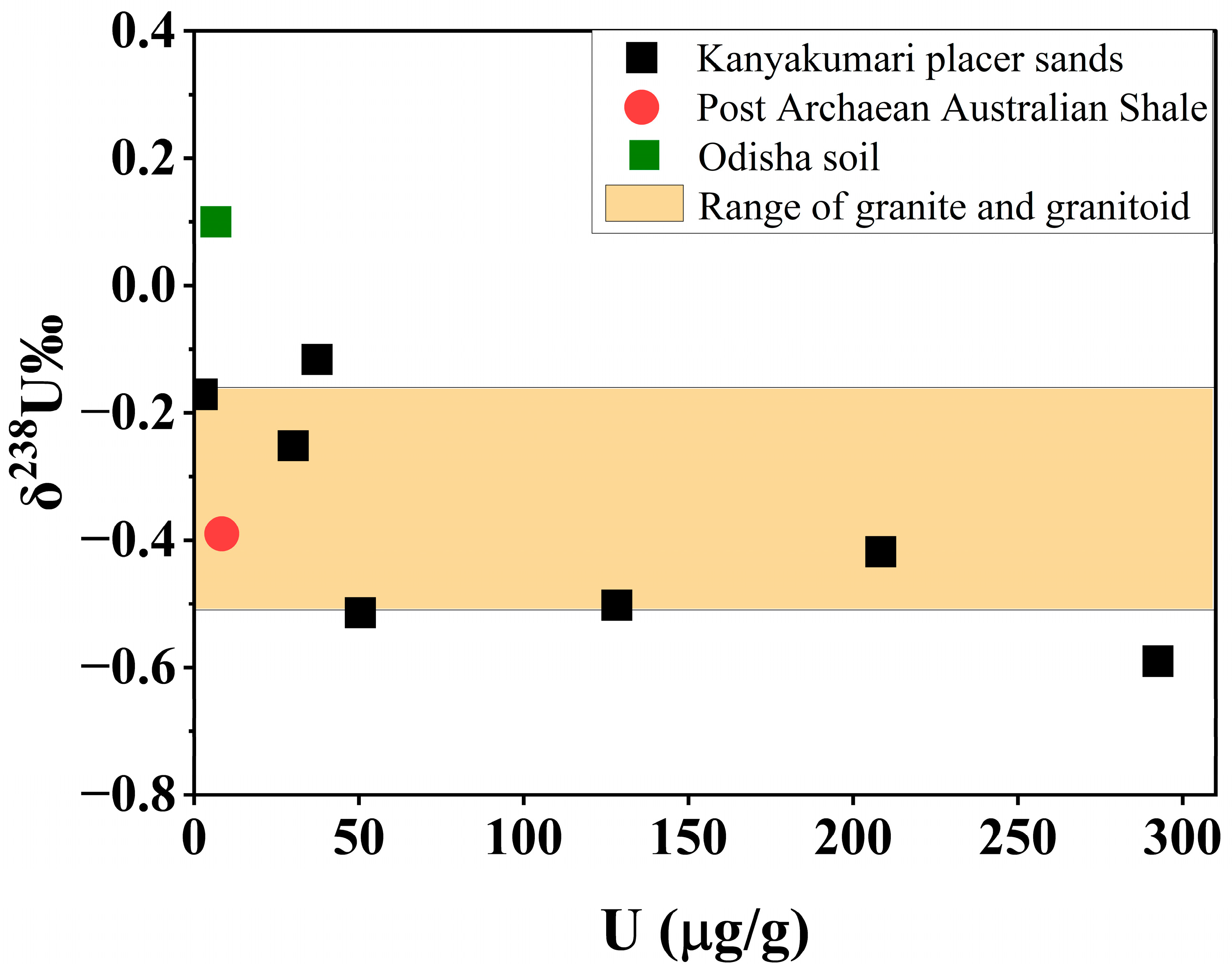
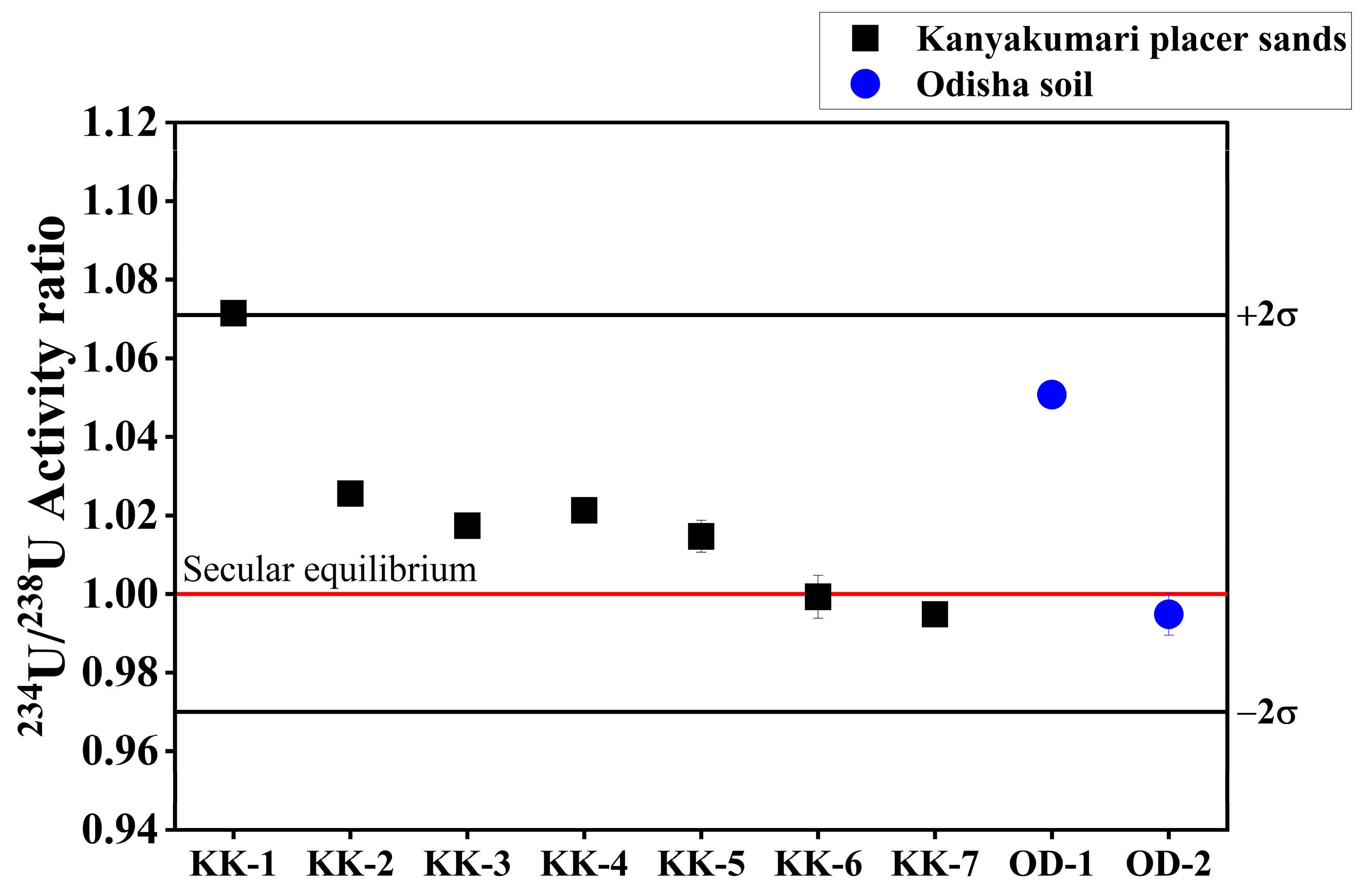
| Sample ID | SiO2 | TiO2 | Al2O3 | Fe2O3 | MgO | CaO | Na2O | K2O | P2O5 | MnO |
|---|---|---|---|---|---|---|---|---|---|---|
| KK-1 | 19.19 | 33.62 | 4.38 | 28.91 | 1.58 | 0.30 | 0.02 | 0.03 | 1.23 | 0.23 |
| KK-2 | 37.07 | 26.91 | 10.06 | 16.20 | 0.97 | 1.04 | 0.17 | 0.02 | 1.16 | 0.19 |
| KK-3 | 23.07 | 35.53 | 2.13 | 28.13 | 0.70 | 0.23 | 0.06 | 0.03 | 1.93 | 0.27 |
| KK-4 | 41.78 | 19.29 | 3.87 | 16.51 | 0.97 | 6.35 | 0.61 | 0.18 | 0.26 | 0.17 |
| KK-5 | 15.78 | 36.82 | 2.39 | 30.28 | 0.96 | 2.35 | 0.15 | 0.04 | 1.17 | 0.29 |
| KK-6 | 32.43 | 27.66 | 3.71 | 20.28 | 0.86 | 5.77 | 0.28 | 0.15 | 2.23 | 0.21 |
| KK-7 | 52.91 | 7.26 | 7.24 | 14.92 | 1.95 | 5.76 | 0.17 | 0.11 | 0.08 | 0.20 |
| SiO2 | TiO2 | Al2O3 | Fe2O3 | MgO | CaO | Na2O | K2O | P2O5 | MnO | Th | U | |
|---|---|---|---|---|---|---|---|---|---|---|---|---|
| SiO2 | 1.00 | |||||||||||
| TiO2 | −0.96 | 1.00 | ||||||||||
| Al2O3 | 0.50 | −0.36 | 1.00 | |||||||||
| Fe2O3 | −0.95 | 0.85 | −0.51 | 1.00 | ||||||||
| MgO | 0.51 | −0.62 | 0.42 | −0.25 | 1.00 | |||||||
| CaO | 0.69 | −0.72 | −0.25 | −0.65 | 0.18 | 1.00 | ||||||
| Na2O | 0.42 | −0.42 | −0.27 | −0.56 | −0.23 | 0.76 | 1.00 | |||||
| K2O | 0.54 | −0.59 | −0.34 | −0.57 | 0.03 | 0.93 | 0.86 | 1.00 | ||||
| P2O5 | −0.62 | 0.73 | −0.27 | 0.51 | −0.63 | −0.41 | −0.39 | −0.30 | 1.00 | |||
| MnO | −0.79 | 0.72 | −0.50 | 0.89 | −0.25 | −0.56 | −0.62 | −0.61 | 0.47 | 1.00 | ||
| Th | −0.63 | 0.71 | −0.46 | 0.49 | −0.71 | −0.23 | −0.15 | −0.07 | 0.96 | 0.39 | 1.00 | |
| U | −0.69 | 0.63 | −0.26 | 0.67 | −0.32 | −0.59 | −0.49 | −0.36 | 0.68 | 0.50 | 0.63 | 1.00 |
| Element | KK-1 | KK-2 | KK-3 | KK-4 | KK-5 | KK-6 | KK-7 |
|---|---|---|---|---|---|---|---|
| La | 2380.83 | 921.43 | 1279.40 | 919.66 | 1335.79 | 3518.94 | 169.90 |
| Ce | 4952.03 | 1934.59 | 2832.51 | 1892.50 | 3082.93 | 7149.88 | 379.65 |
| Pr | 531.78 | 213.98 | 332.24 | 206.92 | 316.41 | 752.14 | 37.85 |
| Nd | 1965.73 | 767.21 | 1265.65 | 795.29 | 1147.36 | 2776.95 | 148.42 |
| Sm | 311.05 | 123.40 | 207.24 | 105.61 | 174.73 | 406.60 | 21.92 |
| Eu | 2.47 | 1.30 | 2.10 | 1.34 | 1.96 | 4.48 | 0.49 |
| Gd | 185.18 | 71.83 | 130.50 | 52.86 | 107.83 | 251.81 | 12.36 |
| Tb | 13.11 | 1.90 | 2.90 | 2.90 | 7.88 | 20.37 | 1.40 |
| Dy | 32.26 | 7.85 | 8.85 | 8.85 | 20.64 | 62.74 | 3.73 |
| Ho | 3.43 | 1.82 | 2.38 | 1.71 | 3.03 | 8.82 | 0.43 |
| Er | 9.00 | 5.22 | 6.01 | 5.07 | 7.87 | 28.42 | 1.42 |
| Tm | 0.76 | 0.47 | 0.51 | 0.65 | 0.88 | 3.06 | 0.15 |
| Yb | 4.59 | 2.63 | 2.48 | 4.31 | 5.77 | 20.34 | 1.03 |
| Lu | 0.59 | 0.60 | 0.35 | 0.62 | 1.10 | 3.00 | 0.20 |
| Th | 796.13 | 632.65 | 1142.11 | 494.44 | 821.86 | 1495.10 | 38.54 |
| U | 208.37 | 30.07 | 292.48 | 37.33 | 50.46 | 128.27 | 2.50 |
| ƩREEs | 10,392.82 | 4054.22 | 6073.13 | 3998.28 | 6214.18 | 15,007.54 | 778.93 |
| (Ce/Yb)N | 279.53 | 190.71 | 295.67 | 113.85 | 138.58 | 91.12 | 95.94 |
| (Ce/Sm)N | 3.84 | 3.78 | 3.30 | 4.33 | 4.26 | 4.24 | 4.18 |
| (Gd/Yb)N | 32.69 | 22.14 | 42.60 | 9.94 | 15.16 | 10.04 | 9.77 |
| La | Ce | Pr | Nd | Sm | Eu | Gd | Tb | Dy | Ho | Er | Tm | Yb | Lu | Th | U | |
|---|---|---|---|---|---|---|---|---|---|---|---|---|---|---|---|---|
| La | 1.00 | |||||||||||||||
| Ce | 1.00 | 1.00 | ||||||||||||||
| Pr | 1.00 | 1.00 | 1.00 | |||||||||||||
| Nd | 1.00 | 1.00 | 1.00 | 1.00 | ||||||||||||
| Sm | 0.99 | 0.99 | 1.00 | 1.00 | 1.00 | |||||||||||
| Eu | 0.98 | 0.98 | 0.98 | 0.98 | 0.96 | 1.00 | ||||||||||
| Gd | 0.98 | 0.99 | 0.99 | 0.99 | 1.00 | 0.97 | 1.00 | |||||||||
| Tb | 0.96 | 0.96 | 0.95 | 0.94 | 0.92 | 0.93 | 0.92 | 1.00 | ||||||||
| Dy | 0.97 | 0.96 | 0.95 | 0.94 | 0.92 | 0.95 | 0.91 | 0.99 | 1.00 | |||||||
| Ho | 0.95 | 0.95 | 0.94 | 0.93 | 0.91 | 0.98 | 0.91 | 0.93 | 0.97 | 1.00 | ||||||
| Er | 0.92 | 0.91 | 0.90 | 0.90 | 0.87 | 0.96 | 0.87 | 0.91 | 0.96 | 0.99 | 1.00 | |||||
| Tm | 0.89 | 0.88 | 0.86 | 0.86 | 0.82 | 0.93 | 0.82 | 0.89 | 0.94 | 0.98 | 0.99 | 1.00 | ||||
| Yb | 0.87 | 0.86 | 0.84 | 0.84 | 0.80 | 0.91 | 0.80 | 0.88 | 0.94 | 0.97 | 0.99 | 1.00 | 1.00 | |||
| Lu | 0.84 | 0.83 | 0.81 | 0.80 | 0.76 | 0.89 | 0.76 | 0.86 | 0.92 | 0.96 | 0.97 | 0.99 | 0.99 | 1.00 | ||
| Th | 0.84 | 0.86 | 0.88 | 0.88 | 0.88 | 0.92 | 0.90 | 0.72 | 0.75 | 0.85 | 0.81 | 0.77 | 0.74 | 0.73 | 1.00 | |
| U | 0.45 | 0.47 | 0.52 | 0.53 | 0.59 | 0.46 | 0.60 | 0.29 | 0.25 | 0.29 | 0.22 | 0.14 | 0.10 | 0.03 | 0.63 | 1.00 |
| Sample ID | U (µg/g) | Activity Ratio | Isotope Ratio | δ238U‰ |
|---|---|---|---|---|
| 234U/238U a | 235U/238U b | |||
| KK-1 | 208.37 ± 2.55 | 1.072 ± 0.002 | 0.0072580 ± 38 | −0.42 |
| KK-2 | 30.07 ± 1.83 | 1.026 ± 0.002 | 0.0072568 ± 32 | −0.25 |
| KK-3 | 292.48 ± 3.12 | 1.017 ± 0.003 | 0.0072592 ± 32 | −0.59 |
| KK-4 | 37.33 ± 0.38 | 1.021 ± 0.002 | 0.0072558 ± 24 | −0.12 |
| KK-5 | 50.46 ± 0.43 | 1.015 ± 0.008 | 0.0072587 ± 32 | −0.51 |
| KK-6 | 128.27 ± 0.99 | 0.999 ± 0.011 | 0.0072586 ± 31 | −0.50 |
| KK-7 | 2.5 ± 0.02 | 0.995 ± 0.003 | 0.0072562 ± 29 | −0.17 |
| OD-1 | 6.63 ± 0.02 | 1.051 ± 0.004 | 0.0072543 ± 31 | 0.09 |
| OD-2 | 1.59 ± 0.02 | 0.995 ± 0.011 | 0.0072493 ± 31 | 0.77 |
Disclaimer/Publisher’s Note: The statements, opinions and data contained in all publications are solely those of the individual author(s) and contributor(s) and not of MDPI and/or the editor(s). MDPI and/or the editor(s) disclaim responsibility for any injury to people or property resulting from any ideas, methods, instructions or products referred to in the content. |
© 2023 by the authors. Licensee MDPI, Basel, Switzerland. This article is an open access article distributed under the terms and conditions of the Creative Commons Attribution (CC BY) license (https://creativecommons.org/licenses/by/4.0/).
Share and Cite
Natarajan, T.; Inoue, K.; Sahoo, S.K. Rare Earth Elements Geochemistry and 234U/238U, 235U/238U Isotope Ratios of the Kanyakumari Beach Placer Deposits: Occurrence and Provenance. Minerals 2023, 13, 886. https://doi.org/10.3390/min13070886
Natarajan T, Inoue K, Sahoo SK. Rare Earth Elements Geochemistry and 234U/238U, 235U/238U Isotope Ratios of the Kanyakumari Beach Placer Deposits: Occurrence and Provenance. Minerals. 2023; 13(7):886. https://doi.org/10.3390/min13070886
Chicago/Turabian StyleNatarajan, Thennaarassan, Kazumasa Inoue, and Sarata Kumar Sahoo. 2023. "Rare Earth Elements Geochemistry and 234U/238U, 235U/238U Isotope Ratios of the Kanyakumari Beach Placer Deposits: Occurrence and Provenance" Minerals 13, no. 7: 886. https://doi.org/10.3390/min13070886
APA StyleNatarajan, T., Inoue, K., & Sahoo, S. K. (2023). Rare Earth Elements Geochemistry and 234U/238U, 235U/238U Isotope Ratios of the Kanyakumari Beach Placer Deposits: Occurrence and Provenance. Minerals, 13(7), 886. https://doi.org/10.3390/min13070886






